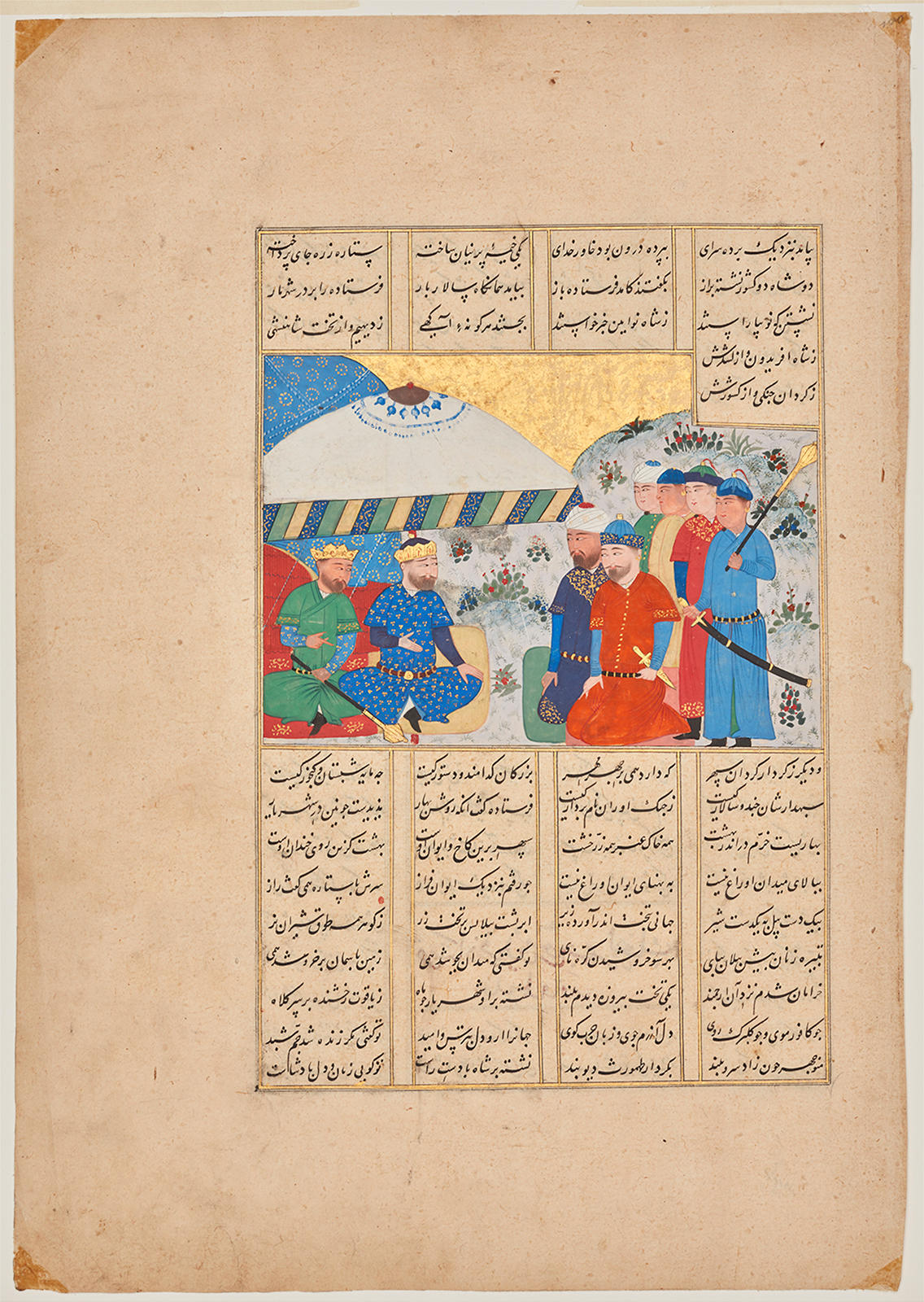Faridun replies to the second message of Salm and Tur,
Chapter 6 - Faridun
Big Head Shahnama, Turkmen, Iran, 1494
Aga Khan Museum AKM63


ALM AND TUR RECEIVING BACK THEIR ENVOYS SPURNED BY SHAH FARIDUN
FOLIO DETACHED FROM A SHAHNAMEH (BOOK OF KINGS) BY ABU’L-QASIM FIRDAUSI (D. 1010)
Accession Number: AKM63
Creator: Copied by Salik b. Sa‘id, and dedicated to Sultan 'Ali Mirza
Place: Iran, Lahijan
Dimensions: 34.5 × 24 cm
Date: ca. 1494
Materials and Technique: opaque watercolour, gold, and ink on paper
The country’s adoption of Islam, Firdausi’s epic poem the Shahnameh (Book of Kings), completed in 1010, inspired many illustrated copies. The present folio depicting an incident from the reign of Shah Faridun was detached from a copy that is known as the “Big Head” Shahnameh (see AKM495 for another treatment of this scene). This name refers to the characteristic feature of the majority of its paintings: the large heads of its human figures.
Further Reading
Shah Faridun’s decision to divide his realm among his three sons Salm, Tur, and Iraj has many tragic consequences. The elder sons grow envious of their younger brother Iraj, and kill him when he attempts to find a peaceful solution. Shah Faridun exacts his revenge after many years, waiting until Iraj’s grandson Minuchihr is old enough to lead an army against his great uncles. Though Salm and Tur send their envoys to beg for peace, Faridun refuses their plea. [1] Salm and Tur are killed by Minuchihr during the war that ensues.
In the present folio, the returned envoys present Faridun’s answer to the two brothers, who are seated side by side. Though all the figures in the scene appear to be generic types, the poses and facial features of the envoys are depicted identically to those in the illustration showing the previous episode, where Shah Faridun spurns the envoys sent by Salm and Tur (see AKM62). This strategy of personalizing figures is used throughout the “Big Head” Shahnameh.
The “Big Head” Shahnameh is today preserved in two separate collections in Istanbul: volume one, in the Türk ve Islam Eserleri Müzesi (TIEM, ms. 1978, formerly Evkaf, Halet Efendi 3079) and volume two, in the Istanbul University Library (F. 1406, formerly Yildiz 7954/310). The first volume bears a dedication to a Sultan ‘Ali Mirza (TIEM 1978, fol. 1a), while the second volume ends with a colophon which gives the name of the dedicatee as Mirza ‘Ali, as well as the name of the scribe, Salik b. Sa‘id, and the date 899/1494 (IUK F. 1406, fol. 304r).
The patron of the manuscript is identified by common consensus in art historical literature as the Shi’ite governor of Gilan, Mirza ‘Ali, from the Karkiya dynasty (r. 1478–1505), whose patronage is otherwise unknown. According to Charles Melville, he is consistently referred to as Mirza ‘Ali in the contemporary sources, as in the colophon of volume two, even though he is called Sultan ‘Ali Mirza in the dedication of volume one, as well as in the secondary literature. [2]
Mirza ‘Ali’s rule covered the crucially important period of the 1501 Safavid takeover of western Iran from the Aqqoyunlu Turkmans (1467–1501). Furthermore, the grandson of the Aqqoyunlu ruler and the future founder of the Safavid dynasty (1501–1724), Isma‘il Safavi, took refuge at the court at Lahijan around the year 1493–94, either just before the beginning or during the production of the “Big Head” Shahnameh. The manuscript thus seems to have been produced and illustrated at exactly the period when the future Safavid shah was at Mirza ‘Ali’s court, which raises the possibility that its creation may be connected to Isma’il’s sojourn in the area.
The manuscript has many unique features. Besides being the only known example from this centre, it is also the only manuscript surviving from the Aqqoyunlu period with more than 300 paintings. In addition, over 40 illustrated folios, which appear to have all been removed from the first volume, are presently found in diverse collections worldwide. Since many of these paintings illustrated subjects that had never been depicted before, it has plenty of newly formulated compositions, which closely follow the text.
The Aga Khan Museum has five “Big Head” Shahnameh folios, see AKM62, AKM64, AKM92 and AKM92.
— Lale Uluc
Notes
[1] Jules Mohl, ed., Shahnama-i Firdausi, 3 vols. (Tabriz: Chapkhana-i Maharat, 1370/1991), 1: 123, verses 691–700; A.G. Warner and E. Warner, trans., The Shahnama of Firdausi, 9 vols. (London: Kegan Paul, 1905–25), 1: 210.
[2] For further reading and all references, see Charles Melville, “The ‘Big Head’ Shahnama in Istanbul and elsewhere: Some codicological and iconographical observations,” (forthcoming).
Source: Aga Khan Museum AKM91
Geneva, Aga Khan Trust for Culture
Title of Work: Shahnama (Big Head)
Manuscript: 2005.1.62-64, 91-92 (Ir.M. 17-17/B, 60-60/A)
Accession Number: 2005.1.63 (Ir.M. 17/A)
Chapter 6 - Faridun (500 years)
Scene: Faridun replies to the second message of Salm and Tur
Dimensions (h x w): 105 x 152 mm
Format: Stepped within borders
Hijri Date: 899
Gregorian Date: 1493 (to nearest hijri year)
School: Turkman Commercial Style
Source: Shahnama Project